Welcome to My Latest Travel Guide! I’m Michael Zhang, a seasoned traveler with extensive international experience, specializing in Chinese destinations. This guide takes you through the Dujiangyan Scenic Area, the world’s oldest operational water-management system without a dam. I’ll share insights into Dujiangyan’s rich history, travel tips, and must-see attractions to help you plan an unforgettable journey.
Summary
- Dujiangyan Scenic Area Introduction
- Map of Dujiangyan Scenic Area
- Why You Need to Visit Dujiangyan Scenic Area
- Things to Do in Dujiangyan Scenic Area
- Recommended Hotels Near Dujiangyan Scenic Area
- How to Get from Chengdu City Center to Dujiangyan Scenic Area
- How to Get from Chengdu Tianfu Airport to Dujiangyan Scenic Area
- How to Get from Chengdu Shuangliu Airport to Dujiangyan Scenic Area
- FAQ
Dujiangyan Scenic Area Introduction
Dujiangyan stands as a monumental irrigation project, unique in its ancient yet enduring design without a dam. It ingeniously utilizes the geographical advantage of being high in the northwest and low in the southeast. By leveraging the natural terrain and water flow at the mountain’s outlet, it facilitates unobstructed water diversion and self-regulating irrigation. This system harmoniously integrates embankments, water distribution, flood discharge, sediment control, and flow regulation, ensuring comprehensive benefits in flood prevention, irrigation, navigation, and community water supply. Remarkably, over 2250 years since its construction, Dujiangyan continues to thrive, increasingly benefiting the society.
- Address: Gongyuan Road, Dujiangyan, Chengdu, Sichuan, China (Apple Maps/Amap)
- Opening Hours:
- March 2 to November 30: 08:00 AM – 06:00 PM
- December 1 to March 1: 08:00 AM – 05:30 PM.
- Recommended Visiting Time: 3-4 hours
- Ideal Seasons for Visiting: All year round
- Ticket Price: 80 RMB
- How to Buy Tickets: Click to Purchase
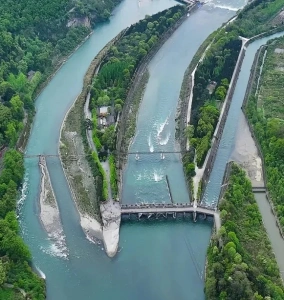
Map of Dujiangyan Scenic Area
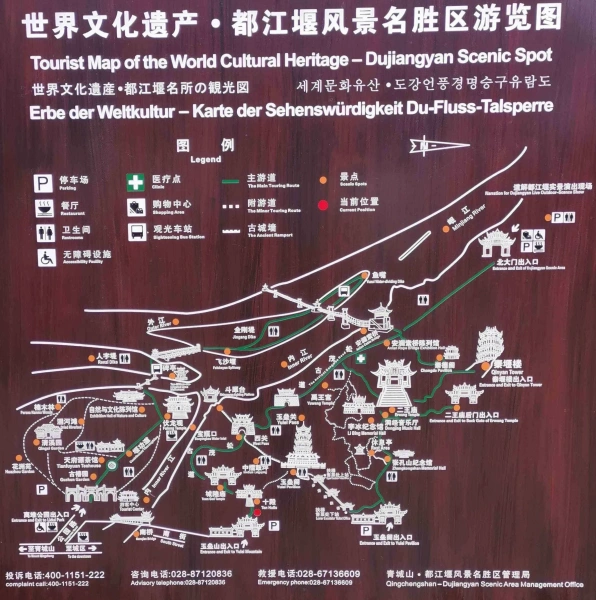
Why You Need to Visit Dujiangyan Scenic Area
Historical Value
The Dujiangyan Scenic Area boasts over 2000 years of history, a testament to the ingenuity of ancient Chinese laborers and a marvel in the history of hydraulic engineering. Initiated in 256 BC by Li Bing, the local governor of the Qin state, it still plays a crucial role in flood control and irrigation today. Dujiangyan not only solved the flooding problem on the Chengdu Plain but also transformed the land into one of richness, earning the moniker “The Land of Abundance.”
Cultural Significance
More than just an irrigation project, Dujiangyan is a symbol of culture, reflecting the technological and humanistic spirit of ancient society. Key structures like the Feisha Weir, Baopingkou, and Yuzui showcase ancient wisdom in utilizing natural conditions through clever design and construction, achieving harmony between humans and nature. Moreover, detailed explanations within the scenic area allow visitors to appreciate the ancient wisdom alongside modern hydraulic technology.
Natural Landscape and Ecological Value
The surrounding mountains and rivers of the Dujiangyan Scenic Area create a unique ecosystem, providing a habitat for various flora and fauna. With lush vegetation and fresh air, the area changes beautifully through the seasons—blossoming peach trees in spring, lush greenery in summer, vibrant autumn leaves, and a wintry silver landscape. This natural beauty and ecological wealth draw countless tourists for sightseeing and relaxation.
Things to Do in Dujiangyan Scenic Area
Dujiangyan Irrigation System
The Dujiangyan Irrigation System utilizes the local geographical advantage of being higher in the northwest and lower in the southeast. Based on the unique terrain and water flow at the river’s outlet, it ingeniously diverts water without the need for a dam, facilitating self-regulating irrigation. This system integrates embankments, water distribution, flood discharge, sediment control, and flow regulation into a cohesive system that ensures comprehensive benefits for flood prevention, irrigation, navigation, and community water use. The core structures of the Dujiangyan water hub include the Fish Mouth Levee, Flying Sand Weir, and Bottle Neck, which work together to control and harmonize water distribution and flood management, boasting the efficiency of “dividing waters with a ratio of four to six, ensuring flood and drought management.”
Fish Mouth Levee
Known as the “Fish Mouth,” this spillway is named for its fish-like shape, prominently positioned at the heart of the Min River. It comprises the Baizhang Dyke, Magpie Weir, and Diamond Dyke, a set of interrelated structures. Its primary function is to split the turbulent Min River into two branches: the outer river on the west, known as the “Golden Horse River,” serves as the main channel for flood discharge, while the inner river along the mountain base serves primarily for irrigation. This arrangement allows over 80% of the Min River’s total sediment load to be diverted through the outer river, optimizing irrigation and flood management.
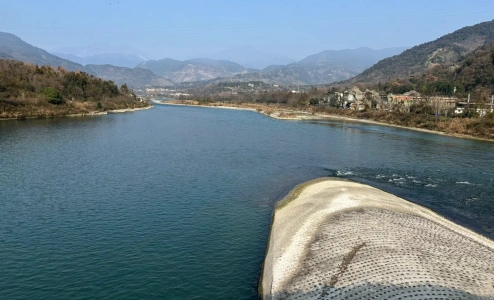
Flying Sand Weir
Also known as the “Spillway,” the Flying Sand Weir plays critical roles in flood mitigation, sediment control, and water flow regulation, hence its name. Located in the middle of the diversion dam, it not only manages floodwaters but also utilizes the vortex action of water flowing over the weir into the outer river to effectively reduce sediment accumulation before and after the Bottle Neck. Key functions include water blocking, flood division, and sand discharge, encapsulated by the six-character mantra “deep dredging of pools, low construction of weirs” from the traditional water management proverb.
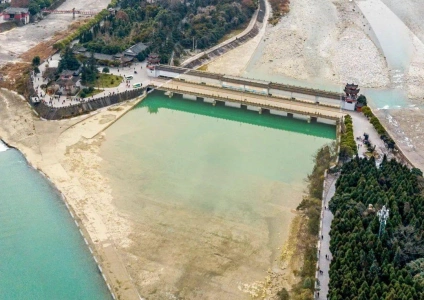
Bottle Neck
The Bottle Neck serves as the intake of the inner river and functions as a control sluice that automatically regulates the water entering the inner river. It is carved into a long ridge extending from Jianshan (now known as Guankou Mountain and Yulei Mountain) into the Min River, shaped like a bottle’s neck with unique controlling features. The hill to the right of the Bottle Neck, named “Li Dui,” was once part of Tiger Head Rock on Jianshan before the Bottle Neck was carved. Due to its spectacular natural scenery and historical significance, the Bottle Neck is one of the renowned “Ten Sights of Guanyang.”
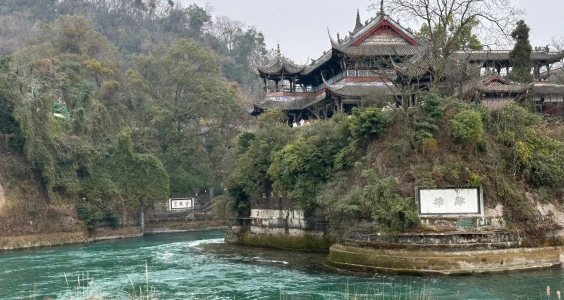
Dujiangyan Scenic Area Ticket Guide
Ticket Prices for Dujiangyan Scenic Area
- Adults: 80 RMB
- Children: 40 RMB, for children aged 6 (excluding) to 18 years old (inclusive).
- Students: 40 RMB, for undergraduate students and below.
- Seniors: During non-Chinese Public Holidays, seniors aged 60 (inclusive) to 64 (inclusive) enjoy free admission; during public holidays, the same age group pays 40 RMB.
- Free Admission: Children under 6 years old and seniors aged 65 and above.
- Opening Hours:
- March 2 to November 30: 08:00 AM – 06:00 PM
- December 1 to March 1: 08:00 AM – 05:30 PM.
Ticket Purchase Channels
- Online: Via WeChat Public Account or online booking platforms.
- Onsite: Available at each entrance of the scenic area.
Dujiangyan Scenic Area Tour Guide Services
Dujiangyan Scenic Area offers official human-guided tours and audio guide devices.
- Guided Tours:
- Booking locations:
- Just inside the main gate, Gate 1, on the left at the pavilion (Route One), the tour path includes: Main South Entrance → Lidui Park (featuring the Three Treasures of Water Control, Yan Gong Dao, and Zhang Song Ginkgo) → Bottle Neck → V-shaped Overflow Weir → Flying Sand Weir → Diamond Weir → Anlan Cable Bridge → ending at the Fish Mouth.
- Outside Gate 6, at the Qin Yan Tower ticket window on the right (Route Two), the tour path includes: Qin Yan Tower (Gate 6 of Dujiangyan Scenic Area) → Two Kings Temple → Anlan Cable Bridge → Fish Mouth → Diamond Weir → Flying Sand Weir → V-shaped Overflow Weir → Bottle Neck → Lidui Park exits the south gate of Dujiangyan Scenic Area.
- Languages: Chinese, English
- Chinese Guided Tour Costs:
- Route One: 90-minute tour, group rate 90 RMB/person, private group 500 RMB/group.
- Route Two: 150-minute tour, group rate 120 RMB/person, private group 800 RMB/group.
- English Guided Tour Costs:
- Route One: 90-minute tour, group rate 40 RMB/person, private group 300 RMB/group.
- Route Two: 150-minute tour, group rate 80 RMB/person, private group 500 RMB/group.
- Booking locations:
- Audio Guides:
- Rental locations: Available at each entrance
- Languages: Chinese, English
- Cost: 30 RMB rental fee, 200 RMB deposit
Recommended Tour Routes in Dujiangyan Scenic Area
- Route from Gate 6: Qin Yan Tower → Two Kings Temple → Anlan Cable Bridge → Fish Mouth → Flying Sand Weir → Fulong Temple → Bottle Neck → exit at Lidui, then left to Nan Bridge to watch the Blue Tears show at 6:30 PM.
- Duration: 3 hours, efficient and not physically demanding, suitable for families with elderly or children, all downhill.
- Route from Gate 1: Lidui Main Gate → Yan Gong Dao → Fulong Temple → Small Cable Bridge → Bottle Neck → Flying Sand Weir → Fish Mouth → Anlan Cable Bridge → Qin Yan Tower → Two Kings Temple → Songmao Ancient Trail → Yulei Pass → West Gate → Yulei Pavilion → West Gate → City God Temple → Ten Halls → Yulei Mountain exit → Guan County Ancient City.
- Duration: 4 hours, a comprehensive tour of the scenic area, essentially a large loop with some hills, requiring moderate physical effort and time.
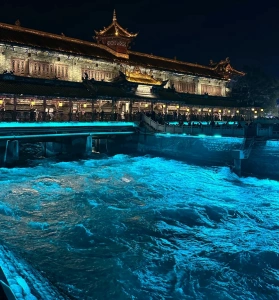
Recommended Local Cuisine Near Dujiangyan Scenic Area
Greenstone
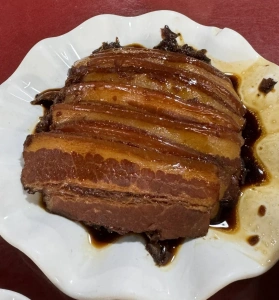
- Why We Recommend It: Popular for its hotpot, skewers, and Sichuan-style “Mao Cai”, offering excellent flavors.
- Address: No. 886 Waibei Street, Dujiangyan, Chengdu, Sichuan, China (Apple Maps/Amap)
- Operating Hours: Monday to Sunday, 11:00 AM – 8:00 PM
- Average Cost per Person: 42 RMB
Fangliangfen Home Cooking Restaurant
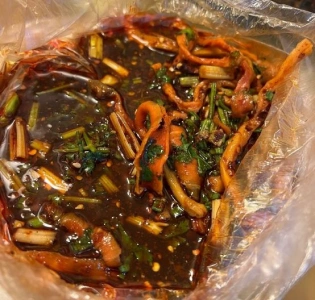
- Why We Recommend It: A long-established eatery known for its authentic local flavors.
- Address: 9-13 Sanguanqiao Down Street, Dujiangyan, Chengdu, Sichuan, China (Apple Maps/Amap)
- Operating Hours: Monday to Sunday, 9:00 AM – 9:00 PM
- Average Cost per Person: 36 RMB
Recommended Hotels Near Dujiangyan Scenic Area
M. Designer Hotel (Dujiangyan Scenic Area Branch)

- Why We Recommend It: Excellently located in the heart of Dujiangyan, this hotel offers superb access to local transport and is surrounded by attractions.
- Price per Night: 200 RMB
- More Information and Booking: Click to View
Mplus Designer Hotel

- Why We Recommend It: Just a 5-minute drive from Nan Bridge, this hotel offers convenient access and rooms filled with natural light, allowing you to wake up to the first rays of sunshine over the ancient city.
- Price per Night: 250 RMB
- More Information and Booking: Click to View
Sunac Rongchuang Siboge Hotel, Chengdu

- Why We Recommend It: Located near Sunac attractions, with Snow World, Sunac Amusement Park nearby, and close to Panda Valley and Dujiangyan by taxi. A high-end hotel brand.
- Price per Night: 690 RMB
- More Information and Booking: Click to View
How to Get from Chengdu City Center to Dujiangyan Scenic Area
High-Speed Train
Start your journey from Chengdu Xipu Railway Station, and take the high-speed train to Lidui Park. The ticket costs 10 RMB per person, and the journey takes about 30 minutes. Be sure to avoid getting off at Dujiangyan Railway Station as it is further from the scenic area. From Lidui Park Station, it’s a 15-minute walk to Gate 1 of the Dujiangyan Scenic Area. For those heading to Gate 6, a taxi is recommended, which should take about 15 minutes and cost between 20-30 RMB.
- High-Speed Train Route: Xipu (犀浦) <-> Liduigongyuan (离堆公园)
- Ticket Purchase: Click to Buy Tickets
How to Get from Chengdu Tianfu Airport to Dujiangyan Scenic Area
Metro + High-Speed Train
From Chengdu Tianfu Airport, take the Metro Line 18 to transfer to Metro Line 1 and then to Metro Line 2, reaching Xipu Station. From there, switch to a high-speed train bound for Lidui Park, which costs 10 RMB per person and takes about 30 minutes. It’s a 15-minute walk from Lidui Park Station to Gate 1 of Dujiangyan Scenic Area. For Gate 6, a taxi is recommended, which takes about 15 minutes and costs 20-30 RMB.
- High-Speed Train Route: Xipu (犀浦) <-> Liduigongyuan (离堆公园)
- Ticket Purchase: Click to Buy Tickets
How to Get from Chengdu Shuangliu Airport to Dujiangyan Scenic Area
Metro + High-Speed Train
From Chengdu Shuangliu Airport, take Metro Line 10 to Metro Line 7 and then to Metro Line 2 to reach Xipu Station. Transfer to a high-speed train headed to Lidui Park Station. The entire trip takes approximately 1 hour and 45 minutes, costing about 30-40 RMB per person. From Lidui Park Station, it’s a 15-minute walk to Gate 1 of the Dujiangyan Scenic Area.
- High-Speed Train Route: Xipu (犀浦) <-> Liduigongyuan (离堆公园)
- Ticket Purchase: Click to Buy Tickets
FAQ
Is Dujiangyan Scenic Area Accessible for Strollers and Wheelchairs?
Dujiangyan Scenic Area is equipped with excellent accessibility features, including flat walkways and accessible restrooms, making it suitable for strollers and wheelchairs. The main sightseeing routes are wheelchair-friendly, and wheelchair rental services are available on site for visitors who need them. However, some historically significant areas might not be fully accessible due to terrain restrictions, so it’s advisable to plan your route accordingly.
Where Can I Store Luggage?
At Gate 1 entrance (main gate), there are self-service luggage lockers near the taxi stand. A large locker costs 18 RMB for up to three hours.
Essential Chengdu Travel Resources
- Comprehensive Chengdu Travel Guide 📖
- Chengdu Travel Recommendations 🏙️
- Hotel Recommendations 🏨
- Transportation Guides ✈️ 🚇 🚄 🚆
- Essential Travel Tips & Tools 🗺️ 🍜 📱 💸 🌤️ 💊

 English (US)
English (US)  English (Hong Kong)
English (Hong Kong)  English (Malaysia)
English (Malaysia)  English (Singapore)
English (Singapore)  繁體中文
繁體中文 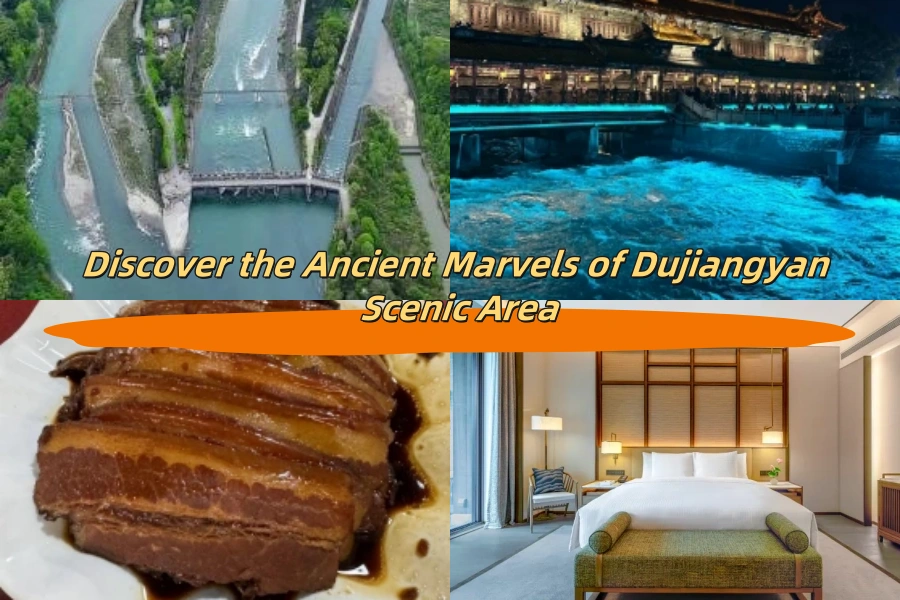
Comment (0)